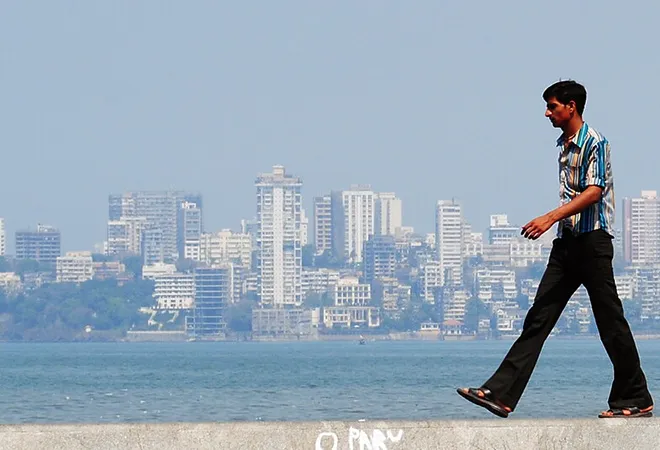-
CENTRES
Progammes & Centres
Location
If one were to go by recent home-grown choices made in Mumbai, a process has started that would catalyse the road to Mumbai’s decline.

Image Source: © Sarah Jamerson/Flickr
Down the centuries, history has been spectator to the rise and fall of many mighty cities. Rome, the first city in the world that became home to a million citizens, dazzled the globe by its magnificence for almost 550 years till the rise of Beijing around 1850. The Chinese city’s dominance, however, was short-lived. The Industrial Revolution propelled London to the fore and by 1900 it became the world’s largest and wealthiest city. Its dominance was outdone by New York around 1950 when this American megacity won global recognition as the financial, cultural and media capital of the world. In a highly competitive world, several other cities are vying to unseat New York from its heights.
Why cities rise and fall is a complex subject. As cities rise, a large population is drawn into the city by the prospects of job, business, trade, art, commerce, education and a better quality of life. Over a period of time, a whole host of factors begin to leave their impact, some beyond the control of individual cities, that tend to pull the city down from its high pedestal. Natural disaster, war, global shift in power, technology and innovation have been important reasons in the basket of causes. There could, however, be significant local factors that decision-makers in a city initiated that ate the vitals of the city and brought its downfall. In India, till the time of independence, Kolkata was an economic powerhouse and the centre of learning, art, culture and theatre. However, three decades down the line, it was overshadowed by Mumbai as the new star city. It cannot be denied that part of the decline of Kolkata was triggered by local decisions, inimical to its economy and extensive appeal.
"Over a period of time, a whole host of factors begin to leave their impact, some beyond the control of individual cities, that tend to pull the city down from its high pedestal."
If one were to go by recent home-grown choices made in Mumbai, a process has started that would catalyse the road to Mumbai’s decline. This is a radical statement and needs to be fact-checked on the basis of credible data. The article’s objective is to put forth facts, figures, actions and decisions that lend support to that argument.
Mumbai has for several decades been the financial capital of India. However, there are indications that Mumbai’s dominance is suffering erosion over time. The city appears to have priced itself out of some of its economic growth due to its prohibitive land prices. Contiguous cities such as Thane and the Mumbai Metropolitan Region (MMR), in general, are likely to outpace Mumbai’s growth trajectory. Since the city is chary of breaking the shackle of rent laws, it has starved itself of affordable and rental housing. Its population that rose feverishly in the earlier decades is predicted to fall by 2031. Millions of people prefer to live outside Mumbai but travel every day to work in the city. This, however, may not last too long, as businesses relocate to cheaper places outside Mumbai.
Additionally, the Municipal Corporation of Greater Mumbai (MCGM) that provides a wide array of municipal services is in financial trouble. The urban local body, reputed for long as the richest municipal entity in the country and widely believed to be running a fairly efficient municipal system, has had to fall on reserves to avoid going into deficit. Several local decisions have brought this situation upon the city government; but first, it would be necessary to clear the misconception about the richness of the municipal body. An ORF article published earlier had clarified the precarious financial position of the city. After a detailed analysis, it had concluded, “In sum, if functions and finances of MCGM are to be matched, the MCGM’s annual budget should be in the region of Rs. 80,000 crores. At the current juncture, it is capable of meeting merely a little more than one-third of its obligations. MCGM is clearly burdened with what we may term a huge unfunded mandate.”
"The Municipal Corporation of Greater Mumbai (MCGM) that provides a wide array of municipal services is in financial trouble."
Despite such a situation, the state government went ahead and decided to waive property taxes in Mumbai for all residential properties that measure less than 500 square feet. This has given a large setback to the finances of MCGM. Since property rates in Mumbai are obscenely high, large units are beyond the reach of Mumbaikars. Hence, a majority of residences, around 64 percent, in the city are below 500 square feet. The new concession permits almost two-thirds of properties to escape the property tax net. Newspaper reports suggest that there has been a 34 percent drop in property tax collection by MCGM this year. Since property tax is globally the most significant source of municipal revenue, this was clearly an unwise step.
GST has piled further misery on the MCGM. By subsuming taxes such as octroi, advertisement tax and entertainment tax, it has further narrowed the tax base of MCGM and made it even more dependent on the state and the center. Post the abolition of cited taxes, MCGM’s top three income sources, apart from octroi compensation by the state (32 percent) were property tax (22 percent), premiums (21 percent) and interest on deposits (8 percent). All three have now been compromised.
The situation is reflected in MCGM’s Rs. 33,441 crore budget of 2020-21. The expenditure outlay has had to be funded by a withdrawal from reserves of Rs. 4,380 crores. At this rate, reserves are most likely to completely dry up in a decade, leaving no internal elbow room. With the exemptions granted to properties below 500 sq. ft. there is already a shortfall of Rs. 335 crores. This can be concealed by showing the mopping up of large tax arrears. However, much of these are locked in litigation.
"A sizeable hole has been drilled into property tax earnings through exemptions. Since misfortune does not come alone, the situation has been further compounded by COVID-19, leading to a steep drop in revenues from premiums."
As we have mentioned above, a sizeable hole has been drilled into property tax earnings through exemptions. Since misfortune does not come alone, the situation has been further compounded by COVID-19, leading to a steep drop in revenues from premiums. These were earnings that were recovered from fresh real estate developments that took place in the city. However, the pandemic and the general economic downturn have led to a collapse of real estate activity drying up this source of municipal revenue. And since reserves are being depleted, interest from deposits would recede. More misfortune has been piled up on the city by the losses being suffered by its transport organisation, the BEST. MCGM must also make up for its losses.
The overall result of financial stress would be a deterioration in the standards of service, a cut in maintenance outlays and a more run-down look of the city. There is a large scope of raising tax rates, cutting down on inessential services and restrictions on manpower recruitment. However, knowing the political climate in local bodies, political parties are not likely to show any stomach for tough decisions. The picture is clear. The possibility of reversing Mumbai’s fortune appears remote.
The overall financial situation of ULBs around the country has been poor and experts have been arguing that a fair share of GST is essential to shore up municipal finances. In the case of Mumbai, however, this line of argument may not have much impact. If the state and ULB are prepared to forego taxes by giving sops to citizens, surely, they do not need external assistance. This year’s MCGM budget has presented a happy Mumbai as vision 2030. With no proper home to stay, the daily grind of hours of commute, high cost of living, little recreational space, falling quality of basic services and the pandemic’s preference for Mumbai as the city of its choice, that appears to be an exercise in surrealism.
The views expressed above belong to the author(s). ORF research and analyses now available on Telegram! Click here to access our curated content — blogs, longforms and interviews.

Dr. Ramanath Jha is Distinguished Fellow at Observer Research Foundation, Mumbai. He works on urbanisation — urban sustainability, urban governance and urban planning. Dr. Jha belongs ...
Read More +